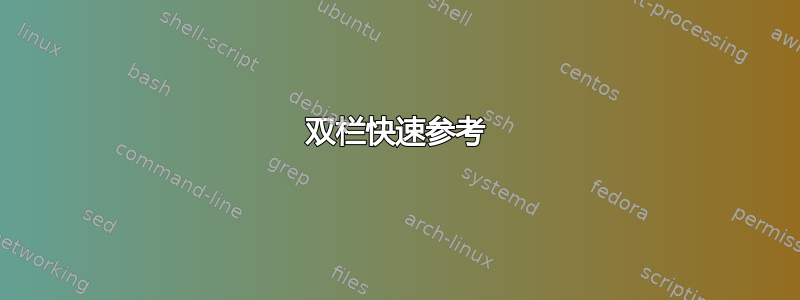
答案1
这是解决您的问题的一种方法:
- 第 1 部分:照常撰写文本,使用
\section和\subsection - 第 2 部分:使用
\twocolumn自己的命令替换部分\qrs内容\qrsub - 第 3 部分:与第 2 部分相同,但使用
\onecolumnANDpackage multicol
完成第 1 部分后,另请参阅下面代码中的此注释:
这里最有趣的部分可能在开始处:计数器和自己的命令的定义和使用。
定义计数器并将其初始化为 0 很简单:
\newcounter{cqr}% counting "sections"
\setcounter{cqr}{0}
\newcounter{csqr}% counting "subsections"
\setcounter{csqr}{0}
\section可以通过例如以下方式进行替换,其中\thecqr返回 counter 的值cqr,其余的只是根据需要排版,并#1保留您将传递的标题:
\newcommand\qrs[1]{% acting as "section"
\stepcounter{cqr}% increment "section"-number
\setcounter{csqr}{0}%
\begin{center}%
\textbf{QR\thecqr. #1}%
\end{center}%
}
请注意,在增加“section”时会初始化“subsections”替换的计数器。现在,subsection替换看起来非常相似,但排版略有不同:
\newcommand\qrsub[1]{% acting as "subsection"
\stepcounter{csqr}%
\begin{flushleft}%
\hrule%
\bigskip%
\textbf{QR\thecqr.\thecsqr\ }(#1)%
\end{flushleft}%
}
(PS:很多%都是必要的。)
就我个人而言,我可能更喜欢单列/多列方法,而不是双列方法。
\documentclass[10pt,a4paper]{article}
\usepackage{lipsum}
\usepackage{multicol}
% ~~~ QR-"sections" and "subsections" ~~~
\newcounter{cqr}% counting "sections"
\setcounter{cqr}{0}
\newcounter{csqr}% counting "subsections"
\setcounter{csqr}{0}
\newcommand\qrs[1]{% acting as "section"
\stepcounter{cqr}% increment "section"-number
\setcounter{csqr}{0}%
\begin{center}%
\textbf{QR\thecqr. #1}%
\end{center}%
}
\newcommand\qrsub[1]{% acting as "subsection"
\stepcounter{csqr}%
\begin{flushleft}%
\hrule
\bigskip
\textbf{QR\thecqr.\thecsqr\ }(#1)%
\end{flushleft}%
}
% ~~~~~~~~~~~~~~~~~~~~~~~~~~~~~~~~~~~~~~~~~
\begin{document}
Strategy: start small, refine later
% PART 1
% ------------------------------
\section{Triangulated categories}
\subsection{Distinguished triangles}
Write some math-text here, like $a^2 + b^2 = c^2$, which you can also list as:
\begin{itemize}
\item case 1: $c^2 \in R$
\item case 2: $c^2 \in C$
\end{itemize}
\subsection{Canonical functions}
Same as above. $E = m c^2$. Same as above. Same as above. $E = h \nu$. Same as above.
% ------------------------------
\section{Sheaves}
\lipsum[4]
\subsection{The six operations}
Same as above.
% ~~~~~~~~~~~~~~~~~
\bigskip
\fbox{Now let's try some things:}
\begin{itemize}
\item using twocolumn and setting columnwidth
\item using self-defined qrs to replace sections and counter cqr
\item using self-defined qrsub to replace subsections and counter csqr
\item use onecolumn and package multicol
\end{itemize}
% ~~~ now let's copy and introduce changes ~~~~~
% PART 2
\twocolumn[\begin{center}%
\huge{\textbf{Quick reference}}%
\end{center}]% starts a new page in two columns
\setlength{\columnwidth}{4cm}
% ------------------------------
\qrs{Triangulated categories}
\qrsub{Distinguished triangles}
Write some math-text here, like $a^2 + b^2 = c^2$, which
you can also list as:
\begin{itemize}
\item case 1: $c^2 \in R$
\item case 2: $c^2 \in C$
\end{itemize}
\qrsub{Canonical functions}
Same as above. $E = m c^2$. Same as above. Same as
above. $E = h \nu$. Same as above.
% ------------------------------
\qrs{Sheaves}
\lipsum[4]
\qrsub{The six operations}
Same as above.
To fill the rest of the page:
\lipsum[1-2]
% ~~~ now let's use onecolumn and multicol ~~~~~
% PART 3
\onecolumn% starts a new page in one column
\begin{center}%
\huge{\textbf{Quick reference}}%
\end{center}
\vspace{5mm}
\setcounter{cqr}{0}% resetting the QR-counter
\setlength{\columnsep}{3cm}
\begin{multicols}{2}
% ------------------------------
\qrs{Triangulated categories}
\qrsub{Distinguished triangles}
Write some math-text here, like $a^2 + b^2 = c^2$,
which you can also list as:
\begin{itemize}
\item case 1: $c^2 \in R$
\item case 2: $c^2 \in C$
\end{itemize}
\qrsub{Canonical functions}
Same as above. $E = m c^2$. Same as above.
Same as above. $E = h \nu$. Same as above.
% ------------------------------
\qrs{Sheaves}
\lipsum[4]
\qrsub{The six operations}
Same as above.
To fill the rest of the page:
\lipsum[1]
\end{multicols}
\end{document}





